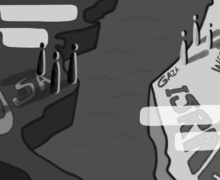‘Cendrillon’ isn’t your average ‘goody two-shoes’ Cinderella story
Cassandra Roshu | Photo Editor
Attendees of the prince's ball gawk at the newfound love between the prince and Cendrillon, played by Alexandra Dubaniewicz. On April 13, SU students performed the opera “Cendrillon,” a French, modern rendition of Cinderella.
Get the latest Syracuse news delivered right to your inbox.
Subscribe to our newsletter here.
In the final moments of Saturday’s “Cendrillon” opera performance, the student performers sang in unison, their voices reverberating from the high ceilings of Syracuse University’s Skybarn. The students’ full skirts swayed with their walks, as the lead, Cendrillon, walked down the aisle.
“What I hope the students, student body and audience take away is opera is here and opera can be fun,” director Julia Ebner said.
On April 13, students in AMC 540, Opera Workshop, performed the opera “Cendrillon,” a French rendition of Cinderella, written by composer and teacher Pauline Viardot in 1904. Ebner chose “Cendrillon” for her students to perform because it shows the modernity of opera with comedic appeal and a female composer.
Ebner said she translated parts of the opera, simplified it and tried to capture the lighthearted spirit of the French version. Supertitles were displayed during the show so audience members could follow along with the singing and some of the French dialogue.
“It’s like a three-ring circus because we are trying to work on vocal technique, stage presence and French pronunciation,” Ebner said.
Throughout the semester, Ebner provided students with voice notes of French words to prepare for the performance. The opera’s lead, Alexandra Dubaniewicz, said she and her peers had to understand the meaning of the French words and ensure their lines were delivered with intention, a process that proved to be difficult.
Although operas are works from the 19th and 20th centuries, this version of “Cendrillon” shows that opera is not a thing of the past, Ebner said.
Written by a female composer, the female characters have more dimensionality, Dubaniewicz said. In the traditional story, Cinderella is a soft-spoken “goody-two-shoes,” while in this rendition, Cendrillon proves to be a sassy and witty character, she said.
“It’s good to have a new refreshing take on it and to be able to play a female character who has depth,” Dubaniewicz said. “We’ll always have the traditional version of the operas but having a new take brings a fresh audience to opera.”
Due to the production being part of a SU class, it was not provided any additional funding. Without a stage crew, the behind-the-scenes work became the responsibility of Ebner and her students.

Cassandra Roshu | Photo Editor
Julianne Stein plays the role of Count Barigoule. The production was part of an SU class, so the cast was also responsible for the behind-the-scenes work.
Josie Diodato helped the show’s development. She played one member of the slipper trio, as a girl who attempts to fit into Cinderella’s glass slipper, but also helped design and fit costumes.
“Everything that’s being done behind the scenes is being done by the castmates. Everyone is working really hard and without that, we wouldn’t have been able to put on the production,” Dubaniewicz said.
Pianist Maryna Mazhukova said the show was a valuable experience. Students learned how to better their stage presence and understand how to collaborate well. She said the work by the cast and Ebner sought to change stereotypes of opera as stiff and outdated.
“When you get to watch an opera you just forget everything, you forget the outside world exists, it just takes you in and it’s so alive,” Mazhukova said. “You can get so absorbed in it, it doesn’t have to be lifeless.”
Viardot’s work serves as an inspiration for those involved in the opera, Mazhukova said. Dubaniewicz said Viardot’s ability to become renowned in a time where men dominated much of the music industry is a testament to the increasingly diverse future of opera.
“Viardot had five kids and she managed to teach, sing and compose so I think we should all aspire to do that — especially those who are in music programs,” Mazhukova said. “I think it’s a very inspiring story.”
Published on April 14, 2024 at 9:57 pm






